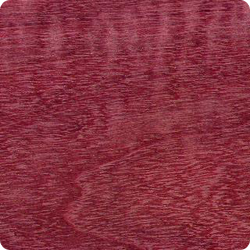Detailed Specs: Purpleheart
Scientific Name: Peltogyne spp.
Family: Caesalpiniaceae
Other Names: Palo morado (Mexico), Morado (Panama, Venezuela),Koroboreli (Guyana), Violetwood (English Trade), Amarante (French Guinana), Pauroxo, Gaurabu (Brazil)
The Tree
The tree grows to heights of 170 feet with diameters up to 4 feet. However, 1.5-3 feet boles are straight, cylindrical and clear 60 to 90 feet above the buttress up to 12 feet high.
The Wood
General Characteristics: The wood is dull brown in appearance when freshly cut and rapidly oxidizes to violet purple upon exposure to light where it gradually reduces to a dark purplish brown over time. The sapwood is either cream or whitish in colour and the grain is generally straight. Its texture is medium to fine; lustre is medium to high, does not have any distinctive odour or taste.
Weight: Basic specific gravity (oven dry weight/green volume) 0.67 to 0.91; air- dry density 50 to 60 pcf.
Drying and Shrinkage: Reports may vary from air dries easily to moderately difficult; dries slowly and fairly rapidly; with almost no degrade to some warping and splitting. Kiln schedule T6-D2 is suggested for 4/4 stock and T3-D1 for 8/4. Shrinkage green to ovendry: radial 3.2%, tangenial 6.1%; volumetric 9.9%. Stability after manufacture or movement is rated small.
Working Properties: This wood is moderately difficult to work with either hand or machine tools, dulls cutters and exudes a gummy resin when heated by dull tools. Slow feed rates and especially hardened cutters are suggested. Turns smoothly, easy to glue and takes finishes well.
Mechanical Properties: (First set of data based on the 2-in standard; second on the 2-cm standard and third on 1-cm standard).
|
Moisture |
Bending Strength (psi) |
Modules of Elasticity (1000 psi) |
Maximum Crushing Strength (psi) |
| Green (75)
12% Green (30) 15% 12% (24) |
13,690
19,220 21,000 26,700 30,900 |
2,000
2,270 2,560 N/A 3,460 |
7,020
10,320 9.250 12,200 14,500 |
Janka side hardness ranges from 1860 lb. to 3920 lb. at 12% moisture content. Forest Products Laboratory toughness at 12% moisture content ranges from 157 to 398 in-lb. (5/8-in specimen).
Durability: Rated highly durable against attack by decay fungi; highly resistant to termites.
Distribution: Distribution is centred in the north-middle portion of the Brazilian Amazon Region with a combined range of all species from Mexico through Central America and down to Southern Brazil.
Preservation: Heartwood is reportedly extremely resistant to impregnation with preservative oils; sapwood is permeable.
Uses: It is an excellent structural timber suitable for heavy outdoor construction work such as bridges, dock work and park benches. It can also be used as flooring because of its high wearing qualities and is suitable for most high traffic areas. In addition, it i s also used in chemical plants for vats, filter press plates and frames. Also used for making billiard cue butts, tool handles, interior and exterior joinery and shipbuilding.
References
– Chundnoff, Martin (1984), “Tropical Timbers of the World.” USDA Forest Service Ag. Handbook No.607.



